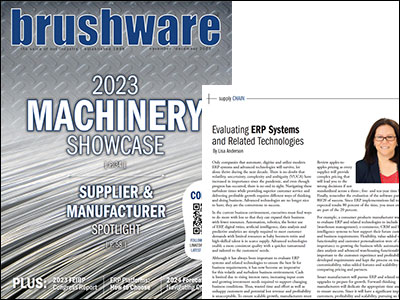Only companies that automate, digitize, and utilize modern ERP systems and advanced technologies will survive, let alone thrive during the next decade. There is no doubt that volatility, uncertainty, complexity, and ambiguity (VUCA) have increased in importance since the pandemic, and even though progress has occurred, there is no end in sight. Navigating these turbulent times while providing superior customer service and delivering profitable growth requires different ways of thinking and doing business. Advanced technologies are no longer nice-to-have; they are cornerstone to success.
In the current business environment, executives must find ways to do more with less so that they can expand their business with fewer resources. Automation, robotics, the better use of ERP, digital twins, artificial intelligence, data analysis and predictive analytics are simply required to meet customer demands with limited resources as baby boomers retire and high-skilled talent is in scarce supply. Advanced technologies enable a more consistent quality with a quicker turnaround and tailored to the customers’ needs.
Although it is always better to evaluate ERP systems and related technologies to ensure the best fit to business requirements, it has become an imperative during these volatile and turbulent times. Cash is limited due to rising interest rates, increasing input costs, and greater investment needs required to support changing business conditions. Thus, wasted time and effort as well as unhappy customers and potential lost revenue and profitability is unacceptable. To ensure scalable growth, manufacturers must evaluate ERP systems and related technologies to protect their cash flow and ensure a robust return on investment.
No matter the system, start with your business requirements. Look beyond bells and whistles and technology salespeople to your business needs. Prioritize the functionality that will support your unique differentiators in the marketplace, your profit drivers, and what’s unique about your industry, product, or service model. In addition to focusing on these requirements, document your full requirements to keep your potential software partners in check. Put together a standard assessment process and expand upon these basic requirements with demonstrations, deep dive discussions, and proof of concepts for your critical success factors.
Review apples-to-apples pricing as every supplier will provide complex pricing that will lead you to the wrong decisions if not standardized across a three-, five- and ten-year time horizon. Finally, keep top of mind that evaluating the software partner is the 80/20 of success. Since ERP implementations fail to deliver expected results 80% of the time, you must ensure you are part of the 20%.
For example, a consumer products manufacturer wanted to evaluate ERP and related technologies to include WMS (warehouse management), e-commerce, CRM, and business intelligence systems to best support their future customer and business requirements. Flexibility, value-added ordering functionality and customer personalization were of critical importance to growing the business while automation, data analysis, and advanced warehousing functionality were important to the customer experience and profitability. We developed requirements and kept the process on track to ensure customizability, value-add features, and scalability while comparing pricing and partners.
Smart manufacturers will pursue ERP and related technology upgrades to prepare for growth. Forward-thinking manufacturers will dedicate the appropriate time and resources to ensure success. Since it will have a significant impact on customers, profitability, and scalability, pursuing an ERP evaluation will be your most important strategy to protect your business. At a minimum, mitigate your customer and financial risk. At a maximum, leverage your ERP system and related technologies to take your business to a new level of performance.
Originally published in Brushware, November/December 2023



